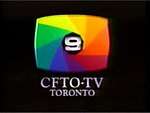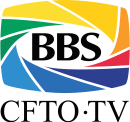CFTO-DT
CFTO-DT, virtual channel 9 (VHF digital channel 8), is the flagship station of the CTV Television Network, licensed to Toronto, Ontario, Canada. The station is owned by the Bell Media subsidiary of BCE Inc., as part of a twinstick with Barrie-based CTV 2 owned-and-operated station CKVR-DT, channel 3 (although the two stations maintain separate operations). CFTO-DT's studios are located at 9 Channel Nine Court in Agincourt (near the junction of Highway 401 and McCowan Road in the former city of Scarborough), and its transmitter is located atop the CN Tower in Downtown Toronto.
 | |
| Toronto, Ontario Canada | |
|---|---|
| Channels | Digital: 8 (VHF) Virtual: 9.1 (PSIP) |
| Branding | CTV Toronto or CTV (general) CTV News Toronto (newscasts) |
| Slogan | Toronto's #1 Newscast Live, Local, and Breaking |
| Programming | |
| Affiliations | CTV (1961–present; O&O since 1998) |
| Ownership | |
| Owner | Bell Media Inc. |
| Sister stations | TV: CP24, CKVR-DT (Barrie) Radio: CFRB, CHUM (AM), CHUM-FM, CKFM-FM |
| History | |
| First air date | December 31, 1960 |
| Former call signs | CFTO-TV (1960–2011) |
| Former channel number(s) | Analogue: 9 (VHF, 1960–2011) Digital: 40 (UHF, 2004–2011) 9 (VHF, 2011–2019) |
| Former affiliations | Independent (1960–1961) |
| Call sign meaning | Canada's Foremost, Toronto's Own |
| Technical information | |
| Licensing authority | CRTC |
| ERP | 10.2 kW |
| HAAT | 467.0 m (1,532 ft) |
| Transmitter coordinates | 43°38′33″N 79°23′14″W |
| Translator(s) | See below |
| Links | |
| Website | CTV Toronto |
The station shares the Agincourt studio complex with CTV's headquarters, which includes studios for the network's news programming (CTV National News and the CTV News Channel), along with most of Bell Media's specialty channels. CTV News has in fact been based at CFTO's studios for most of its history, dating back to the days when the network was a cooperative (CFTO's parent company later acquired most of the other affiliates, eventually becoming the present-day Bell Media) from the station's establishment on January 1, 1961.
CFTO-DT is available in high definition on corporate sister Bell Satellite TV channel 1051,[1] as well as on Shaw Direct channel 133.[2] On cable, the station is carried on Rogers Cable channel 8 in the Greater Toronto Area.[3]
History
The station first signed on the air at 10:00 p.m. on December 31, 1960; its first official day of programming was on January 1, 1961. The inaugural program broadcast on CFTO was a telethon for the Ontario Association for Community Living, hosted by broadcaster Joel Aldred,[4] complete with a fireworks ceremony.
The station was founded by Baton Aldred Rogers Broadcasting, a joint venture between Telegram Corporation (owned by the Bassett and Eaton families), Aldred-Rogers Broadcasting (owned by Joel Aldred and Ted Rogers), and Foster Hewitt Broadcasting, which owned radio station CKFH (1430 AM, now CJCL on 590 AM). The 'Baton' portion of the name was pronounced /ˌbætən/ (as in Baton Rouge, Louisiana), rather than the conducting tool's traditional pronunciation.

The station's first children's show, shown on weekday afternoons, was The Professor's Hideaway, starring Stan Francis.[5][6][7] American television network ABC held a minority share in the partnership, which it sold to each of the partners shortly before CFTO-TV went on the air. Ted Rogers' uncle J. Elsworth Rogers was a minority (and originally primary) owner of Western Ontario Broadcasting, Ltd., owners of CKLW-TV (now CBET) in Windsor, Ontario (which was mostly owned by RKO General). The station's original studio and transmitter facilities were located at 1550 McCowan Road, later renamed 9 Channel Nine Court.

In March 1961, Aldred sold his interest in the station, and on October 1 of that year, CFTO became a charter affiliate of CTV, as well as the network's flagship station. In 1970, Ted Rogers sold his interest in CFTO and the Bassett-Eaton group sold their interest in Rogers Cable in an exchange of assets. On May 31, 1976, CFTO began transmitting its signal from the CN Tower, while its studios remained in Agincourt. CFTO began broadcasting in stereo in 1985. In 1991, the station joined with several other Ontario stations to form Ontario Network Television, which evolved into the Baton Broadcast System, a subsystem within the CTV network. In 1995, CFTO began operating rebroadcast stations at Orillia (on UHF channel 21) and Bobcaygeon (near Peterborough, on UHF channel 54).

When CTV's stations proposed to buy the network and run it as a cooperative in 1966, the Board of Broadcast Governors initially balked at the proposal. CFTO was by far the largest, richest and most profitable station (it was more than double the size of the next-largest station, CFCF-TV in Montreal). This led to fears that CFTO would dominate a station-owned network. The BBG was only appeased when the station owners promised that each owner would have an equal vote, regardless of how large it was. As it turned out, though, Baton gradually grew powerful enough that it was able to buy controlling interest in CTV in 1997, changing its name to CTV Inc. in 1998.
On January 27, 1998, the Eaton family sold its 41% interest in CTV. On that same day, the Baton Broadcast System merged into CTV. With rumours of an impending takeover, Bell Canada proposed to buy CTV Inc. for $2.3 billion; this was approved by the CTV board in March 2000. The deal still required approval from the Canadian Radio-television and Telecommunications Commission (CRTC), but with the promise of the largest benefits package ever presented to the regulators, the deal was approved on December 7 that year. By February 2005, the station stopped using its call letters in its on-air branding (opting to use the "CTV" name), a branding convention that became official on several CTV stations throughout the country in October 2005. BCE later sold most of its interest in CTV, with the parent company being renamed CTVglobemedia. BCE Inc. later reacquired 100% control of CTVglobemedia's assets for $1.3 billion in 2011, with the parent company being renamed once again to Bell Media.
Programming
As CFTO serves as CTV's flagship station, its schedule is virtually identical to the CTV network schedule. A largely identical schedule is used on the other CTV stations in Southern Ontario, CJOH in Ottawa and CKCO in Kitchener, as CFTO acts as master control for these stations. Any discrepancies with other stations would generally be limited to local infomercials and religious programming on Sunday mornings.
Other station productions
Under CTV's original cooperative structure, CFTO, through Baton's in-house production company Glen-Warren Productions, was one of the network's main contributors of Canadian programming, such as The Littlest Hobo, Circus and The Uncle Bobby Show. Indeed, the amount of programming originating at CFTO was often a source of tension with the network's other major-market affiliates. However, as with most local stations in North America, such locally produced non-news programming has become increasingly rare.
For much of its history, CFTO's Channel Nine Court studios have also served as the home for network-produced programs such as CTV National News, Canada AM and W5. The studios are now also used by a number of CTV's specialty channels, for productions such as the cable news channel CTV News Channel, TSN's SportsCentre, and Discovery Channel's Daily Planet.
Over the years, the studio complex has also been rented out for third-party productions, such as the studio scenes in the 1976 film Network.[8] The Lotto 6/49 and Lotto Super 7 (now Lotto Max) drawings were also held at the CFTO studios until 2008. Since 2010, CFTO and CP24 have been the television broadcasters for the Toronto Santa Claus Parade.
News operation

CFTO-DT presently broadcasts 15½ hours of locally produced newscasts each week (with 2½ hours each weekday and 1½ hours each on Saturdays and Sundays). With the exception of its CP24 simulcasts, the station brands its newscasts as CTV News Toronto, in line with all of CTV's other owned-and-operated stations as well as the CTV 2 stations, using generic CTV News graphics. The station's flagship 6:00 p.m. newscast is the highest-rated local newscast in Canada.[9] Known beginning in the 1970s as World Beat News (for its early evening newscast), Noon Beat News (for its lunch hour newscast) and Night Beat News (for its late evening newscast), the station's newscasts were rebranded as CFTO News in early 1998, and as CTV News in 2005.

In December 2008, CP24, a 24-hour news channel which primarily focuses on Toronto, began airing a simulcast of CTV News at Six, displacing its simulcast of the 6:00 p.m. edition of CityNews. This change occurred because the long-standing association between CITY-TV (channel 57) and CP24 (which were previously both owned by CHUM Limited) abruptly came to an end after the CRTC announced the approval of their application by Rogers Media, owners of Citytv, to launch its own 24-hour local news channel which would be focusing on the Greater Toronto Area, CityNews Channel;[10][11] like CFTO, CP24 is operated by Bell Media, although the operations between the two remain otherwise separate. The station's late evening newscast, CTV News at 11:30, was later added to the CP24 schedule in May 2009. On May 12, 2009, CFTO began broadcasting its local newscasts in high definition; with the change, the station introduced a renovated studio.
Starting in July 2017, CFTO began simulcasting CP24's Live at 5 and Live at 5:30 as part of an expansion of local news programming across Bell Media stations. Unlike CP24, Live at 5 and 5:30 is broadcast in full screen without any information sidebars.
Notable current on-air staff
- Michelle Dubé – weekday co-anchor, CTV News at Six
Notable former on-air staff
- Christine Bentley – 6 o'clock news anchor and reporter (retired)
- Dave Devall – weather specialist reporter (retired)
- Tom Gibney – 6 o'clock news anchor (retired)
- Bernie McNamee – reporter (1985–1989), later with CBC Radio 1989–2015 (retired)
- Gord Martineau – reporter (brief stint)
- Ken Shaw – weekday co-anchor, CTV News at Six and CTV News at Noon
- Ali Velshi – reporter
Digital television
Digital channel
| Channel | Video | Aspect | PSIP Short Name | Programming[12] |
|---|---|---|---|---|
| 9.1 | 1080i | 16:9 | CFTO | Main CFTO-DT programming / CTV |
| 9.2 | 480i | 16:9 | CFTO | 16:9 SDTV Vision / CTV |
Analogue-to-digital conversion
The station began providing a digital signal on satellite on November 17, 2003, and on January 30, 2004, CFTO was granted an over-the-air digital television signal, transmitting on UHF channel 40 at an effective radiated power of 17,400 watts. In mid-2005, CFTO upgraded its digital signal to transmit programming in high definition. CFTO shut down its analogue signal, over VHF channel 9, on August 31, 2011, the official date in which Canadian television stations in CRTC-designated mandatory markets transitioned from analogue to digital broadcasts. The station's digital signal was relocated from its pre-transition UHF channel 40 to its analogue-era VHF channel 9 for post-transition operations.[13] On 29 April 2019, CTV will update broadcast channels for stations in Toronto, Victoria, and Windsor. CFTO will broadcast on channel 8, but retain virtual channel 9.1.[14]
Transmitters
| Station | City of licence | Channel (RF / VC) |
ERP | HAAT | Transmitter coordinates |
|---|---|---|---|---|---|
| CFTO-DT-21 | Orillia | 21 (UHF) 21 (PSIP) |
207.6 kW[15] | 171.3 m (562 ft) | 44°52′4″N 79°35′41″W |
| CFTO-DT-54 | Peterborough | 35 (UHF) 54 (PSIP) |
38 kW | 176.3 m (578 ft) | 44°26′44″N 78°31′59″W |
CFTO-TV-21 and a long list of CTV rebroadcasters nationwide were to shut down on or before August 31, 2009, as part of a political dispute with Canadian authorities on paid fee-for-carriage requirements for cable television operators.[16] A subsequent change in ownership assigned full control of CTVglobemedia to Bell Media; as of 2011, these transmitters continue to be licensed and remain in operation.[17] Just after midnight on June 23, 2019, the Orillia transmitter was converted to digital.
References
- "List of Bell Satellite TV Channels". TV Channel Lists. Retrieved July 19, 2020.
- "National Channel Lineup (Numerical)" (PDF). Shawdirect.ca. Shaw Satellite G.P. Retrieved July 19, 2020.
- "List of Rogers TV channels (Toronto)". TV Channel Lists. Retrieved July 19, 2020.
- Joel Walkden Aldred
- Raffi (September 1998). The Life of a Children's Troubadour: An Autobiography. Homeland Press. p. 57. ISBN 978-1-896943-44-2.
- "Here's looking at you, Kiddo" Archived 2017-08-13 at the Wayback Machine. Showbiz, Bill Brioux, Nov 26, 2004
- "Happy Homes for Adoptable Children". Broadcaster, April 25, 1963, page 90
- "ABOUT US". CTV News Toronto. Retrieved October 18, 2015.
- CP24 broadcasts Toronto's Number One Local 6pm Newscast
- What Happened To CityNews On That Cable Channel? Archived 2008-12-14 at the Wayback Machine
- RabbitEars TV Query for CFTO
- Digital Television – Office of Consumer Affairs (OCA) Archived 2013-11-20 at the Wayback Machine
- "Over-The-Air transmitter channel changes". CTV Television Network. Archived from the original on 21 April 2019. Retrieved 21 April 2019.
- ota test
- CTV list of transmitters to be shut down Archived 2011-12-24 at the Wayback Machine
- "CRTC renews licences of most English-language television services: New licence terms to bolster funding for original Canadian programs". Crtc.gc.ca. Archived from the original on 2012-10-05. Retrieved 2015-12-24.
External links
- CTV Toronto
- CFTO-DT history – Canadian Communications Foundation
- CFTO in the REC Canadian station database
- Query TV Fool's coverage map for CFTO